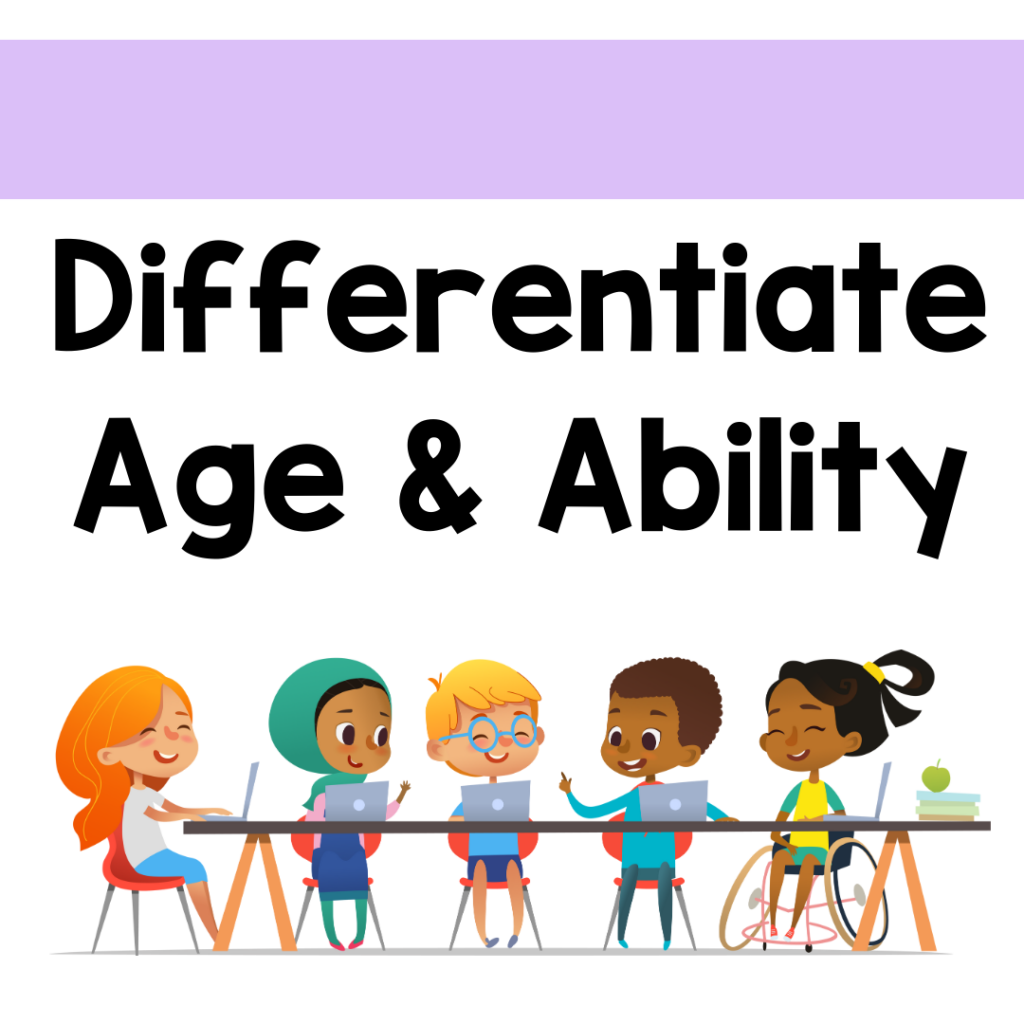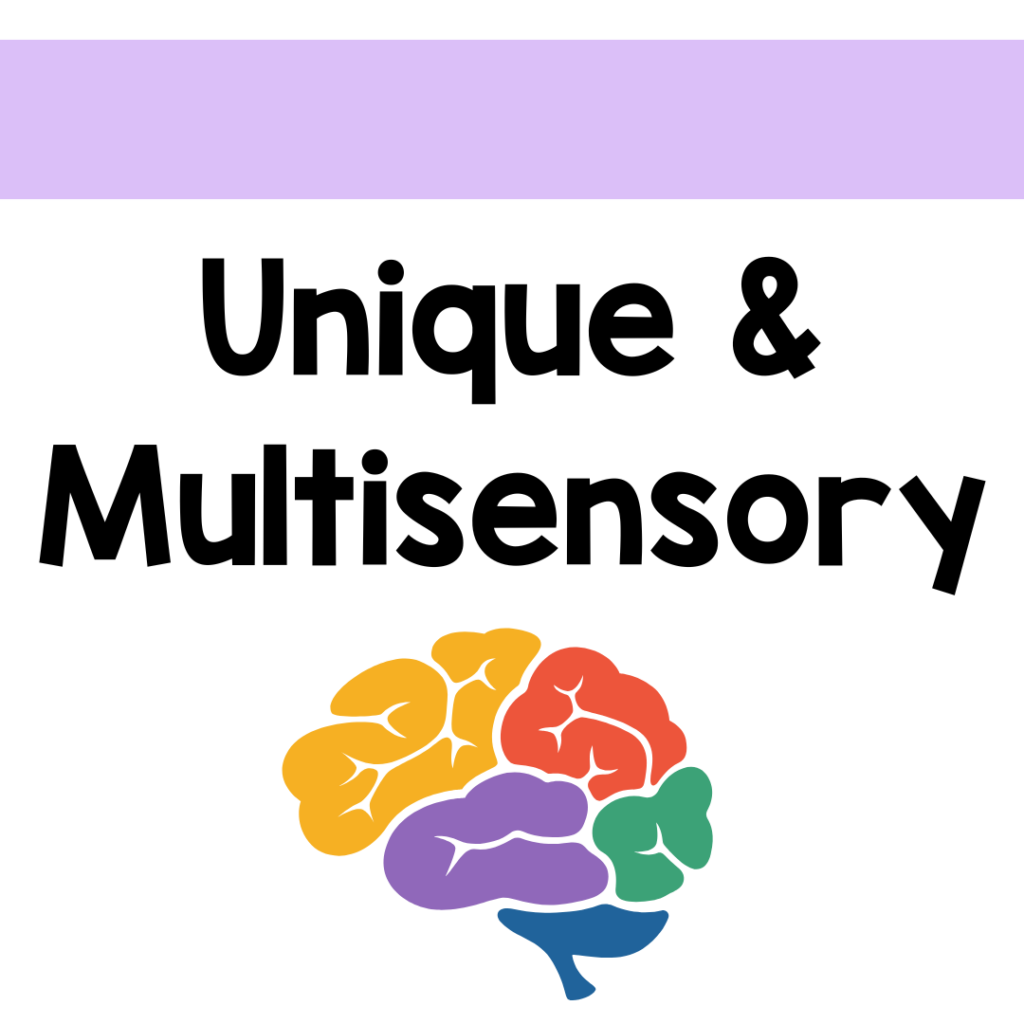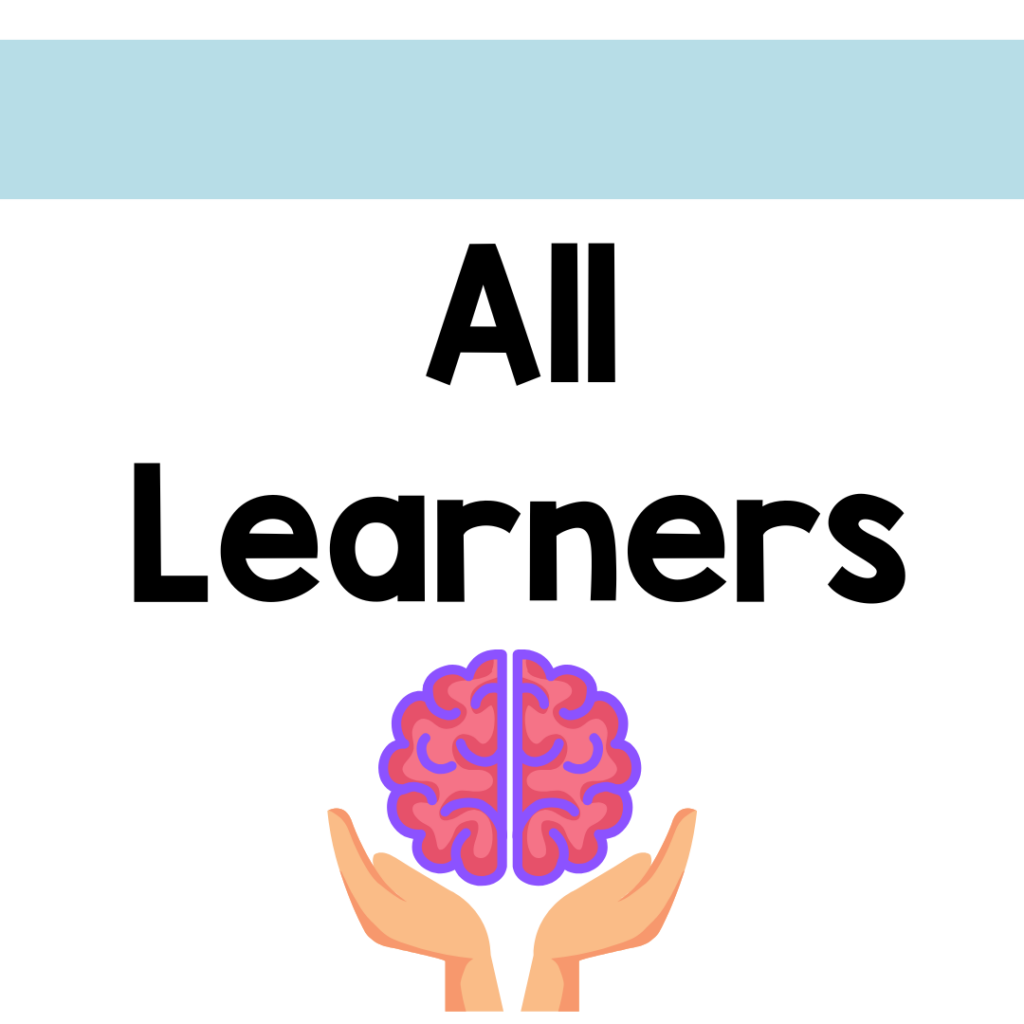
What if I told you I could help eliminate the words “I don’t know what to write!” from your creative writing lessons? Can you imagine your whole class focused on their unique, engaging writing experience despite their academic level and abilities? Instead of staring blankly at a text-based writing prompt, your students will be guided through themed soundscapes to generate story ideas! With this auditory input, your students will discover stories and characters traditional writing methods may have never unlocked!

Whether you are seeking a guided multisensory creative writing activity, a listening activity for your elementary music centers or sub, or an adaptive writing experience for your special education students, these Soundscape Boards with differentiated worksheets are for you!
Soundscapes give your students auditory cues of real-life sounds and related musical selections to enhance the brainstorming process. It has been well loved by students and teachers! Explore why YOU will love it too!
What is a Soundscape?
To put it simply: soundscape (n.): the mixture of different sounds that are heard in a particular place
A soundscape is just the mixing of different sounds we hear around us in our environment. On any given day, we may experience hundreds, if not thousands of different soundscapes. The sounds mixing together in our classrooms will be different from those we hear in our homes. It is no different for a majority* of our students. The unique blend of sound fills their brain on a daily basis.
Using these sounds as a jumping off point for creative writing just makes sense! While I will touch on the matter later in this post, starting off the writing process with sound and music removes language and many cognitive barriers that text-based prompts require.
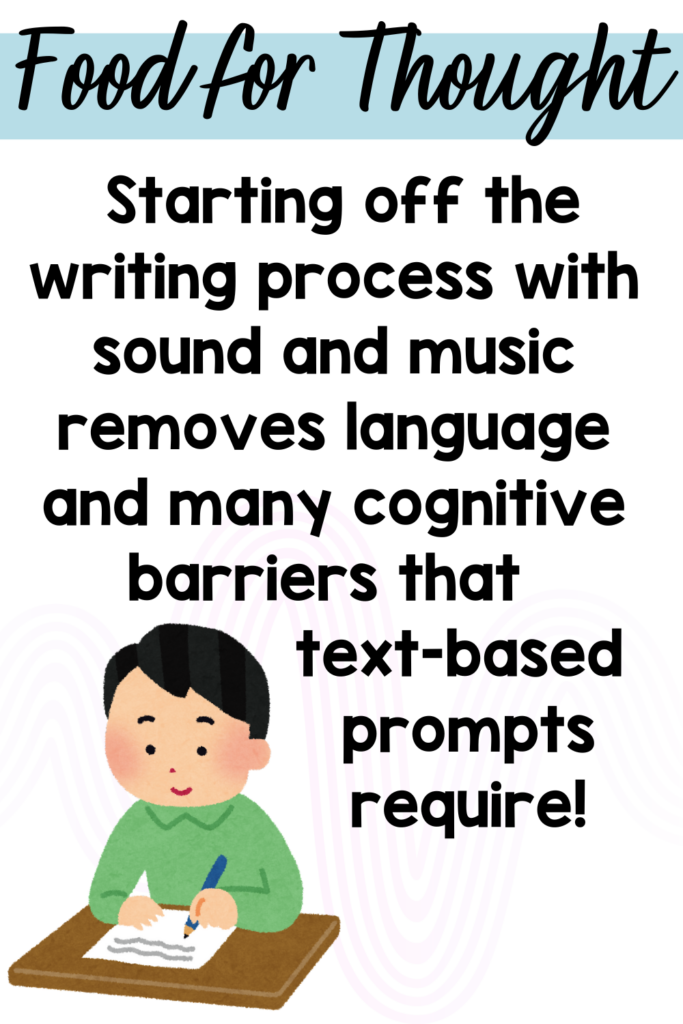
Let’s explore a soundscape activity together!
*While this activity is designed with auditory engagement at its core, it may not fully meet the needs of Deaf and hard-of-hearing learners. However, adaptations such as visual storytelling prompts, hand shape story prompts, written descriptions of sounds, or integrating tactile or visual elements could help make the experience more inclusive. I am hard of hearing, myself. While hearing aids assist me, I fall into the category that may occasionally miss some of the nuances and certain frequency of sounds. Please be patient with your students that may have the same difficulties!
Soundscape Activity Overview
At the core, this activity is so flexible, it can be overwhelming. To simplify, I created a script to assist you through until you can find the swing of what your learners need.

Each soundscape has a common theme that is reinforced with visual icons and pictures. Each sound toggles on and off by a click of a button. You can play more than one sound at a time. The combinations of the 10 sounds can be left to your imagination!

An interactive PowerPoint allows you and your students to explore many different combinations of sounds! Easy to use!

Sound Identification: Each icon will be pressed and students will write simple words or phrases to remember each sound.

Sound to Experiences: Students will have three opportunities to create a soundscape for each short scenario.

Independent Story Creation: Students will experiment with combining multiple sounds to create their own exciting stories!

Guided Story Creation: You will choose one short scenario to play for students. They will write 2-3 short sentences about what they image may be happening.
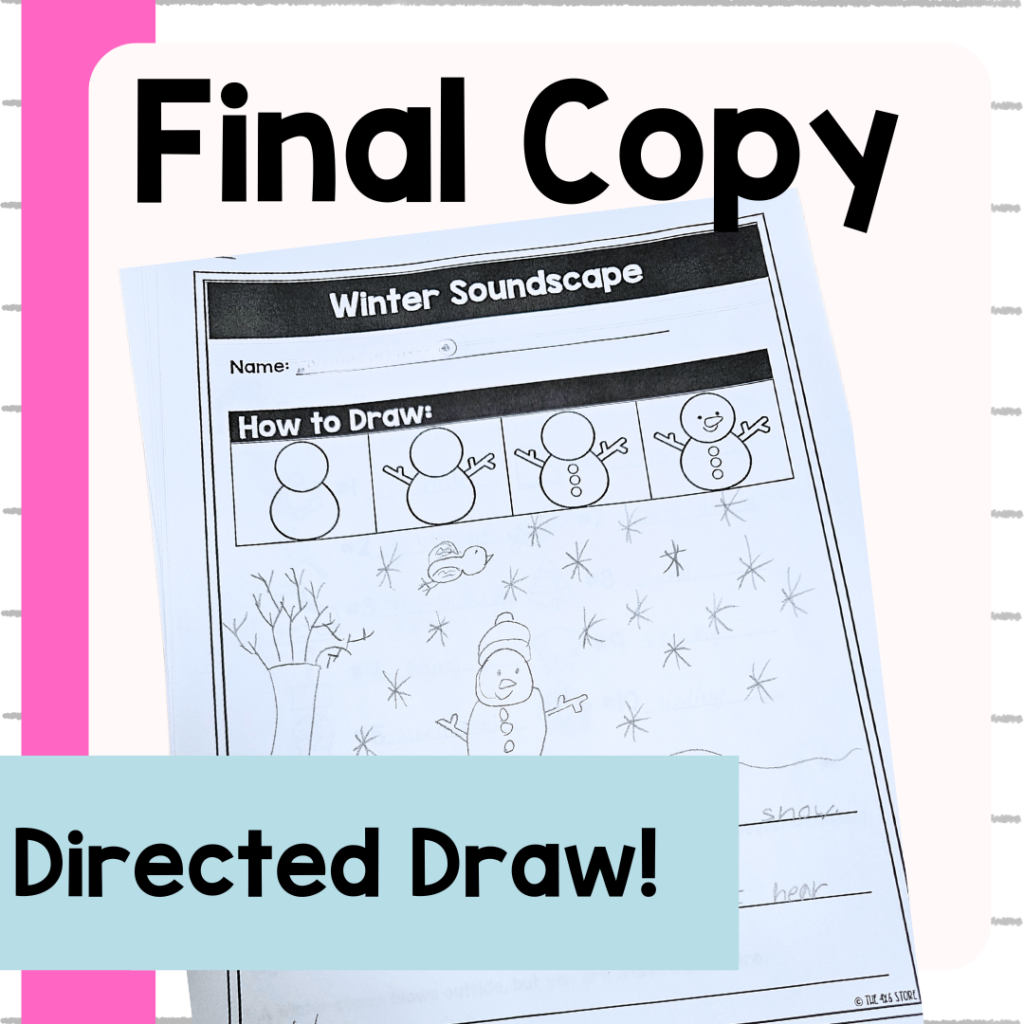
Directed Draw: Students can use a directed drawing worksheet to create a final copy for display! You can also use the drawing pages as a shorter soundscape writing experience.
Beyond developing writing skills or exploring musical expression, these soundscapes can be used to enhance your classroom atmosphere, as a silly reward, in combination with other writing activities, and more! Keep reading to see why these are effective tools for storytelling and listening activities!


Why Choose Soundscapes for Creative Writing or Music Lesson?
There are many reasons why using soundscapes in your classroom can benefit your learners. Use the images below to learn more!
Fresh, Unique Take on Writing

Writing can start to feel the same or repetitive – even with the wide variety of writing prompts available. Utilizing a soundscape experience is a fresh new way to approach creative writing! Your students’ imaginations will not be left to their own devices. Rather, they will be guided by familiar combinations of auditory inputs and simple visual cues.

Our brains do a pretty spectacular job of associating auditory cues to emotions, images, and memories. It can also interpret different sounds to a sense of movement – be it the galloping of a horse, the whir of a spaceship flying by, or elves falling into mischief! For your students who struggle to come up with their own ideas, using sound to stimulate ideas draws on *their* experience with those sounds! Their writing becomes a more authentic experience than making up ….something… from the infinite number of stories.
The experience with adding the sound to images allows students to create more engaging and detailed narratives. It anchors their ideas in the emotions and imagery the sounds evoke. It also allows more diversity with the questions that may be asked while listening: What is happening in this scene? Who might be experiencing these sounds, and why? When have you heard these sounds?
The most interesting part, at least from a teacher’s perspective, is how many different “visions” students create despite hearing the same combination of sounds! It reflects their unique experiences and perceptions of the world!


Practice Writing Elements with Soundscapes

The following are a small sampling of questions you can ask your students as you are completing this activity. Depending on which element of writing you are working on, there are various questions to help students generate more focused ideas or to hit standard specific learning targets.





Appeals to All Learners

The flexible, sensory-rich design of this activity makes it accessible for students with diverse learning needs. The combination of listening, writing, and drawing ensures multiple pathways to understanding and expression, allowing each student to participate in a way that aligns with their abilities and strengths. Each type of learner can connect with one element or another during the experience.
To see how to adapt for your students with ADHD, specific learning accommodations, or are in special education, jump to this section!
Directed Drawing

The directed drawing is an optional component to the soundscape activity. Students can create unique illustrations using the four provided images that fit the theme of the activity. Creating final copies for display in the hallway, student portfolios, or to share with families gives ownership to their creative writing!

Zero Prep

While not the most important feature, being a basically no prep “print-and-go” experience is the cherry on top! The first few pages of the PDF contain an easy to use print guide. Choose the activities and worksheets that are going to provide he most benefit for your students.


How Do I Use Soundscapes in My Content Area?

These soundscapes focus primarily on developing elementary writing skills. However, due to the ease of use and the ability to adapt this activity, it can be used across may different subjects and content areas! Writing is easily integrated into all subjects – but the audio component makes it a perfect fit with music education!
Select your content area below to see specific lesson ideas and modifications for your unique needs!
Soundscapes for Elementary Creative Writing


Incorporating soundscapes into your elementary writing curriculum is a unique and meaningful way foster creativity and expression. The audio sound samples transport your learners into a easy to visualize scene, sparking their imagination and enhancing their ability to visualize and describe settings, characters, and events in their creative writing. It’s an excellent tool for improving descriptive language skills and cultivating a love for storytelling.
If you have a struggling writer or students who struggle to come up with their own stories, adding an auditory environment to your writers workshop is an excellent tool to get their creatively flowing!

This activity can also be the jumping off point of a student created soundscape or other cross curricular unit study enrichment. You can encourage your students to create their own simple soundscapes or stories with sound effects using free sound clips online. It also perfect for hands-on art exploration. With the included directed drawing prompts, children can visualize what they hear in the soundscape and bring their ideas to life on paper. By combining auditory, verbal, and visual activities, this resource aligns beautifully with an approach that values interdisciplinary learning and individualized instruction. It’s a creative way to keep lessons engaging, meaningful, and aligned with different holidays and themed units.
For your mainstream students with ADHD or other sensory processing disorders, using a soundscape can provide a calming, immersive environment that helps them focus on the task. It reduces distractions by engaging their auditory senses in a structured way, while the creative activity allows them to channel their energy productively. The emotional resonance of the soundscape can also be therapeutic for students who have difficulty expressing themselves verbally. The sounds can evoke feelings that students might find easier to describe or communicate creatively, fostering emotional regulation skills and learning and a sense of accomplishment.
Because of the provided script and sub plans, this is an easy activity to have ready for sub, guest teacher, or as before break listening to write activity, too!


Writing Centers:
This activity can be adapted to use in small groups as a center activity. If students have not completed a soundscape before, they will need to be able to read or have received step-by-step instructions for completing. You will also need to provide them with a combination of sounds to toggle for task #3 (listen and write) or have students create soundscapes for each other. You will also need to provide students with individual devices, one device with headphone splitters, or an environment suitable to be able to hear from one laptop or ipad to explore the soundscape.
Alternatively, you can assign just the directed draw page or the listen and draw/write worksheets found in the PDF.


Music Education


This activity provides young musicians with a rich auditory environment that stimulates creativity and enhances listening skills! Using a soundscape also encourages them to connect sounds to emotions, stories, and environments, deepening their understanding of musical expression.
This activity can also be the jumping off point of a student created soundscape. You can encourage your students to compose their own short melodies, or even create their own soundscapes using free sound clips online.
Because of the provided substitute script, this is an easy activity to have ready for a non-music sub or before break listening activity, too!


Music Centers: This activity can be adapted to use in small groups as a center activity. If students have not completed a soundscape before, they will need to be able to read. You will also need to provide them with a combination of sounds to toggle for task #3 (listen and write) or have students create soundscapes for each other. You will also need to provide students with individual devices, one device with headphone splitters, or an environment suitable to be able to hear from one laptop or ipad to explore the soundscape.
Alternatively, you can assign just the directed draw page or the listen and draw/write worksheets found in the PDF.


Special Education (SPED)

Students with learning disabilities and special needs are more likely to need extra support developing writing skills. This activity gives students the opportunity to use multiple senses while exploring the writing process. The visual and auditory cues on the soundscape board provides single topic context clues, generates ideas from previous knowledge, and increases student engagement.

Using an listening based prompt also helps those with reading or English language roadblocks. An auditory prompt allows those who struggle to read or remember traditional writing to feel confident participating in the creative writing process.
For students with ADHD or sensory processing disorders, using a soundscape can provide a calming, immersive environment that helps them focus on the task. It reduces distractions by engaging their auditory senses in a structured way. But, the creative aspect of the activity allows them to channel their energy productively. The emotional resonance of the soundscape can also be therapeutic for students who have difficulty expressing themselves verbally or in writing. The sounds can evoke feelings that students might find easier to describe or communicate creatively, fostering emotional regulation and learning and a sense of accomplishment.
Differentiated pages are also included in these soundscape activities for diverse learning needs and accommodations. These include cut and paste worksheets, simplified sentence prompts with picture words, and drawing focused storytelling.

This activity was developed to have a variety of different writing lines for students needing visual cues for letter formation or as a visual discrimination tool. The tasks also have differentiation based on ability. This includes cut and paste activities, simplified sentence structures, and cards for a visual choice board for non-verbal students.



Homeschool


Incorporating soundscapes into your homeschooling curriculum is a unique and meaningful way foster creativity and expression. Whether you’re focusing on writing, music, or art, this resource offers a multidimensional learning experience. The soundscape transports your child into a easy to visualize scene, sparking their imagination and enhancing their ability to visualize and describe settings, characters, and events in their creative writing. It’s an excellent tool for improving descriptive language skills and cultivating a love for storytelling.
For at home music education, using a soundscape provides an opportunity to explore how sounds can convey mood, setting, and emotion. You can use it as a springboard to teach your child about dynamics, rhythm, and the role of different instruments in creating a sense of place. Encourage them to respond to the music by composing their own short melodies, mimicking the sounds they hear, or even creating their own soundscapes using everyday household sounds or free sound clips online.
This activity is also perfect for hands-on art exploration. With the included directed drawing prompts, children can visualize what they hear in the soundscape and bring their ideas to life on paper. By combining auditory, verbal, and visual activities, this resource aligns beautifully with a homeschooling approach that values interdisciplinary learning and individualized instruction. It’s a creative way to keep lessons engaging, meaningful, and aligned with different holidays and themed units.
You can also feel confident using this with your child with the provided script!



Differentiation

Because sound and music is universal, teachers can use soundboards to differentiate across grade levels and academic abilities. Young preschool students can create stories with the icons on popsicle sticks. Your older students review descriptive adjective and sentences – all from listening to the same sounds!

This product was created with learners capable of reading at a second grade reading level or higher. However, there are many different ways to adapt the activity to work with preschool students all the way through secondary English classes.
For your youngest learners, you can choose to cut out the icons to use as your story telling medium. Objects on each icon can be placed on popsicle sticks for creating small plays, stories, or social situations in conjunction with the soundboard. You can also utilize the cut and paste section for your youngest learners.
For your older learners, you can adapt the activity to focus on more content specific criteria. For example, instead of identifying a sound by what it is, you may have your students use descriptive adjectives, explore onomatopoeia, or other figurative language elements. You can also use this as a calming or regrouping activity to promote SEL in your elementary or secondary classrooms.

Differentiated pages are also included in these soundscape activities for diverse learning needs and accommodations. These include cut and paste worksheets, simplified sentence prompts with picture words, and drawing focused storytelling.

This activity was developed to have a variety of different writing lines for students needing visual cues for letter formation or as a visual discrimination tool. The tasks also have differentiation based on ability such as cut and paste activities, simplified sentence structures, and cards for a visual choice board for non-verbal students.



Standards and Learning Outcomes
This activity can fulfil the requirements for many different writing and music standards across different grades. To help you out with your lesson planning, here are a few standards you can satisfy with this activity:
Writing Standards

This activity aligns with several common writing standards for elementary education, including, but not limited to:
- CCSS.ELA-LITERACY.W.3.3: Writing narratives to develop real or imagined experiences or events using effective technique, descriptive details, and clear event sequences.
- CCSS.ELA-LITERACY.W.3.5: Developing and strengthening writing as needed by planning, revising, and editing.
- CCSS.ELA-LITERACY.W.4.3.A: Orienting the reader by establishing a situation and introducing a narrator and/or characters.
- CCSS.ELA-LITERACY.W.5.3.B: Using narrative techniques such as dialogue, description, and pacing to develop experiences and events or show responses of characters to situations.
- CCSS.ELA-LITERACY.L.4.5: Demonstrating understanding of figurative language and nuances in word meanings, which can be developed through descriptive writing inspired by the soundscape.
These standards emphasize the development of creativity, descriptive language, and structured storytelling, which the soundscape helps facilitate.
Music Standards

This activity also aligns with music education standards, such as:
- National Core Arts Standards (NCAS) – Creating:
- Anchor Standard 1: Generate and conceptualize artistic ideas and work. (e.g., responding to the soundscape by imagining or creating new sounds or music).
- Anchor Standard 2: Organize and develop artistic ideas and work, which can involve composing or arranging sound patterns inspired by the soundscape.
- NCAS – Responding:
- Anchor Standard 7: Perceive and analyze artistic work, such as identifying instruments, dynamics, and tempo within the soundscape.
- Anchor Standard 8: Interpret intent and meaning in artistic work by reflecting on how the sounds convey specific emotions or settings.
- NCAS – Connecting:
- Anchor Standard 11: Relate artistic ideas and works with societal, cultural, and personal meaning. This soundscape encourages by connecting students’ interpretations to holiday themes and traditions.
By linking sound to creative writing, music composition, and critical listening, this activity supports a holistic understanding of artistic expression.




